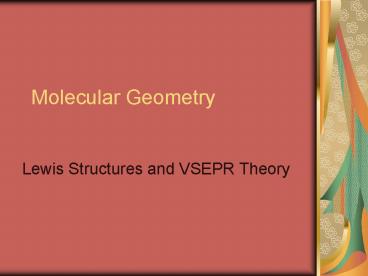Molecular Geometry PowerPoint PPT Presentation
1 / 22
Title: Molecular Geometry
1
Molecular Geometry
- Lewis Structures and VSEPR Theory
2
Lewis Structures
- Also known as electron dot structures
- Shows the positions and bonds of each atom in a
molecule - Example below will be used to illustrate the 6
steps for creating Lewis Structures. - Draw the Lewis structure of iodomethane, CH3I.
3
Lewis Structures Step 1
- Determine the type and number of atoms in the
molecule.
- CH3I
- 1 carbon atom
- 3 hydrogen atoms
- 1 iodine atom
4
Lewis Structures Step 2
- Write the electron-dot structure for each type of
atom in the molecule.
I
C
H
5
Lewis Structures Step 3
- Determine the total number of valence electrons
in the atoms to be combined.
6
Lewis Structures Step 4
- Arrange the atoms to form a skeleton structure
for the molecule. If carbon is present, it is
the central atom. Otherwise, the
least-electronegative atom is central (except for
hydrogen, which is never central). Then connect
the atoms by drawing straight-line bonds. Each
line represents two valence electrons.
H
C
H
H
I
7
Lewis Structures Step 5
- Make sure the central atom has four bonds going
to it if it doesnt add double or triple bonds
to get there. Add unshared electrons so that
each hydrogen atom shares a pair of electrons and
each other nonmetal is surrounded by eight
electrons.
H
C
H
H
I
8
Lewis Structures Step 6
- Count the electrons in the structure to be sure
that the number of valence electrons used equals
the number available.
H
C
H
H
I
9
Resonance Structures
- Sometimes we can draw two or more equally valid
Lewis structures for a given molecule.
O O O
O O O
10
Resonance Structures
- In the past, chemists thought the actual molecule
switched between these two structures the
molecule resonated between the two options - Modern tests show that the molecule has two bonds
of equal length (a 1.5 bond) - We cant draw a 1.5 bond, so we draw the two
resonance structures instead - Put a double-head arrow between the two choices
11
VSEPR Theory
- Valence Shared Electron Pair Repulsion theory
- Electrons have negative charges
- Negatives repel other negatives
- This repulsion means the electron pairs around an
atom spread out as much as possible - We can use this to predict the shape of any
molecule
12
Number of atoms bonded to the central atom Number of lone pairs on the central atom Shape
4 0 tetrahedral
13
Tetrahedral
14
Number of atoms bonded to the central atom Number of lone pairs on the central atom Shape
4 0 Tetrahedral
3 0 Trigonal planar
15
Trigonal Planar
16
Number of atoms bonded to the central atom Number of lone pairs on the central atom Shape
4 0 Tetrahedral
3 0 Trigonal planar
3 1 Trigonal pyramidal
17
Trigonal Pyramidal
18
Number of atoms bonded to the central atom Number of lone pairs on the central atom Shape
4 0 Tetrahedral
3 0 Trigonal planar
3 1 Trigonal pyramidal
2 0 Linear
19
Linear
2 atoms only
20
Number of atoms bonded to the central atom Number of lone pairs on the central atom Shape
4 0 Tetrahedral
3 0 Trigonal planar
3 1 Trigonal pyramidal
2 0 Linear
2 2 Bent
21
Bent
22
Predict these shapes
NH3
H2O
CO2
N
H
H
O
H
H
C
O
O
H
trigonal pyramidal
bent
linear

